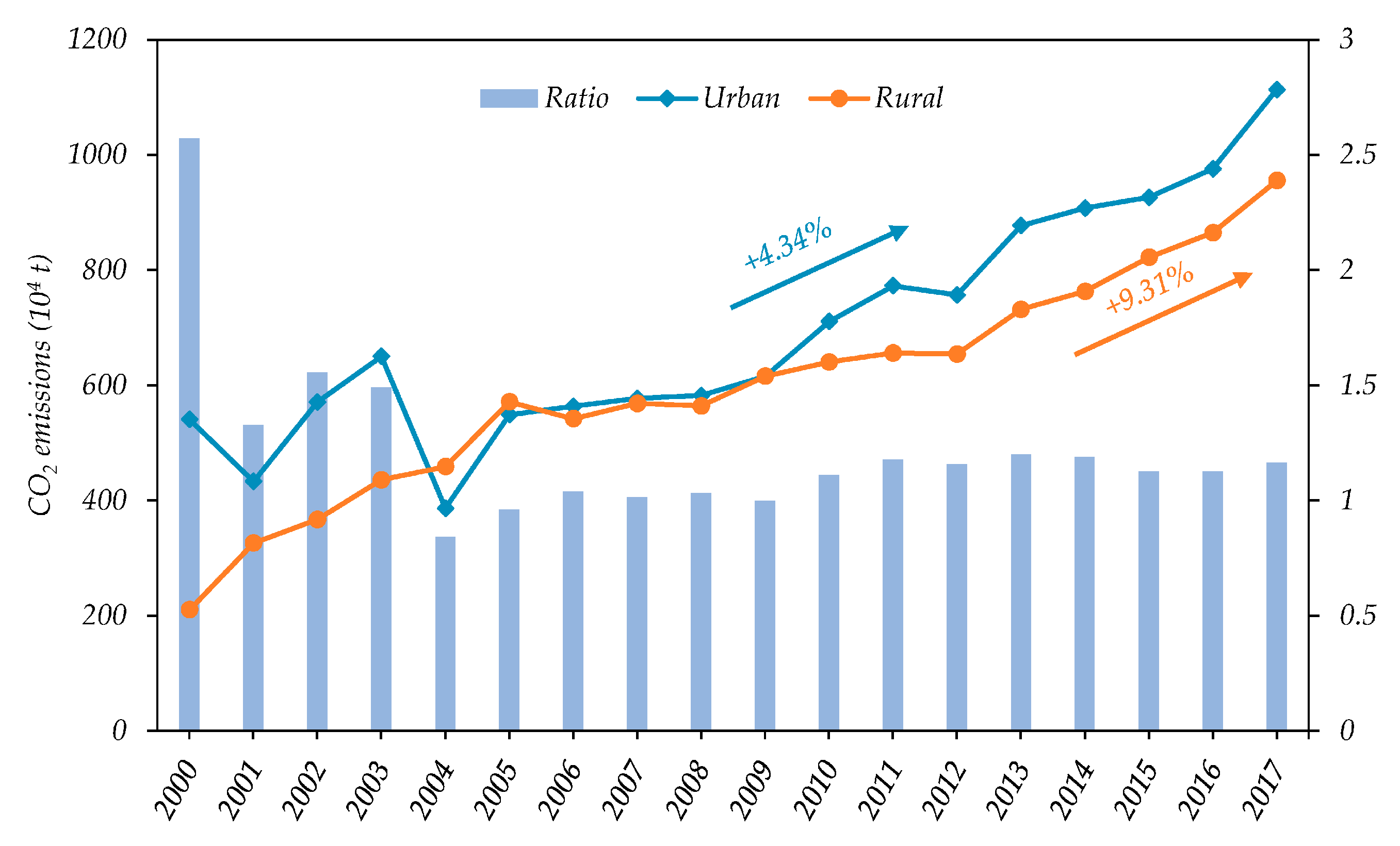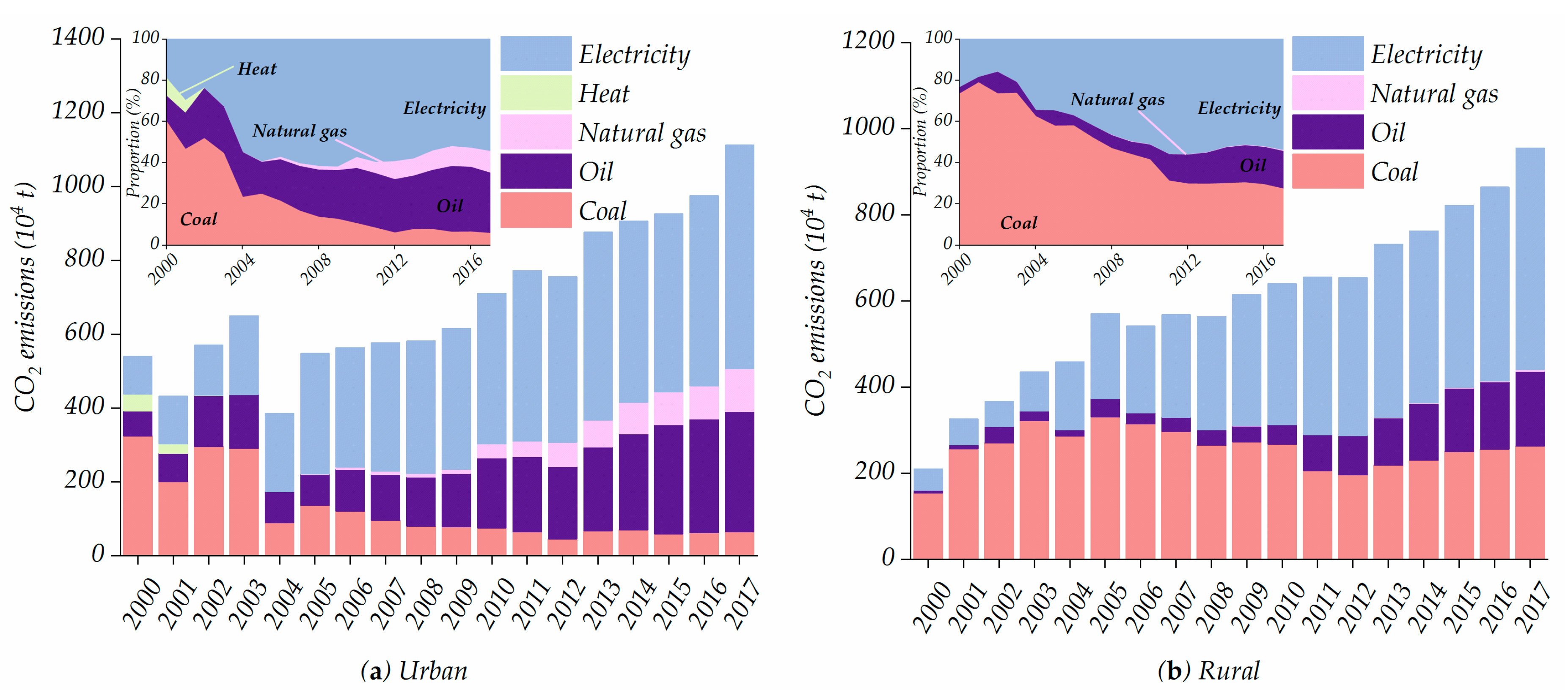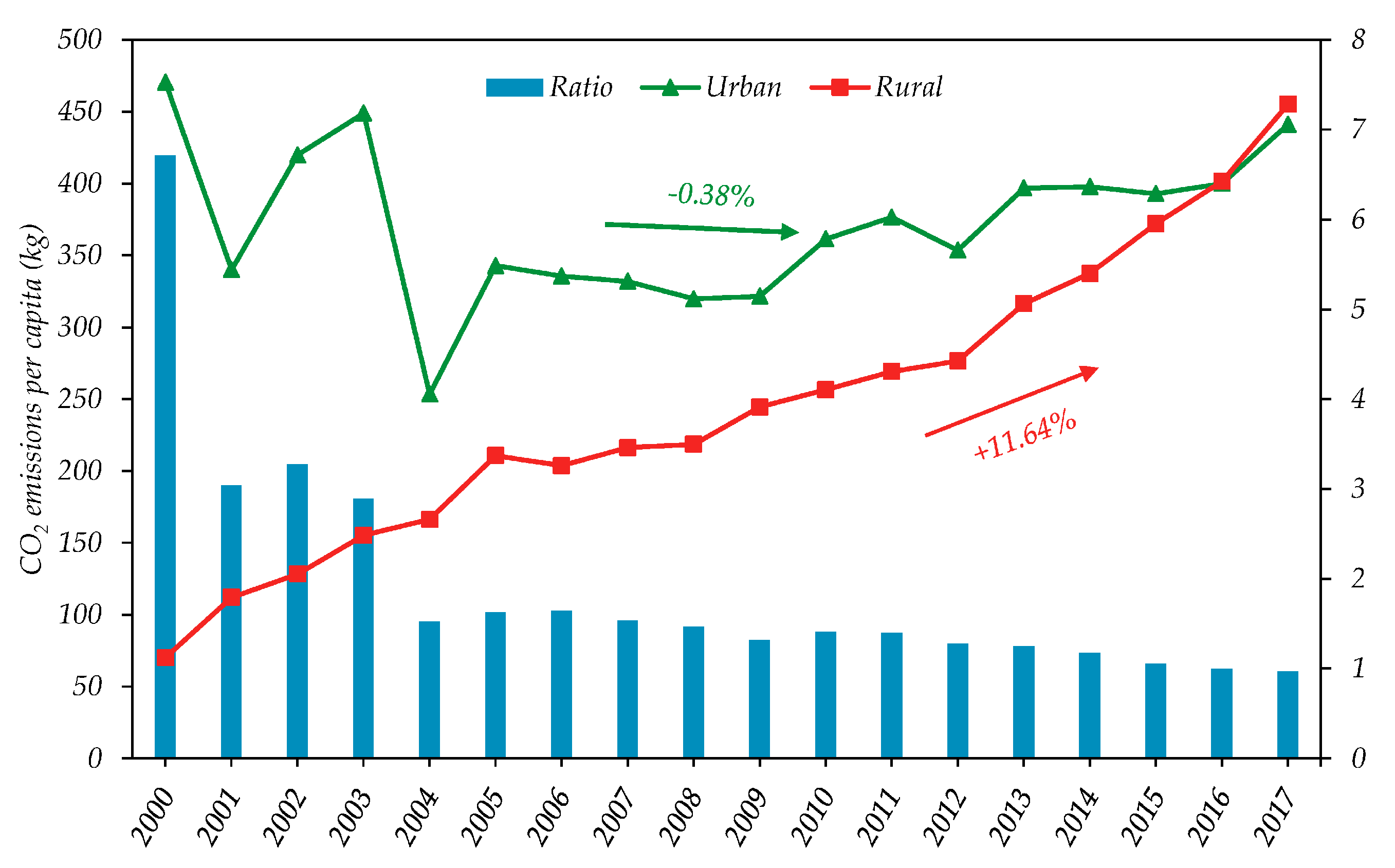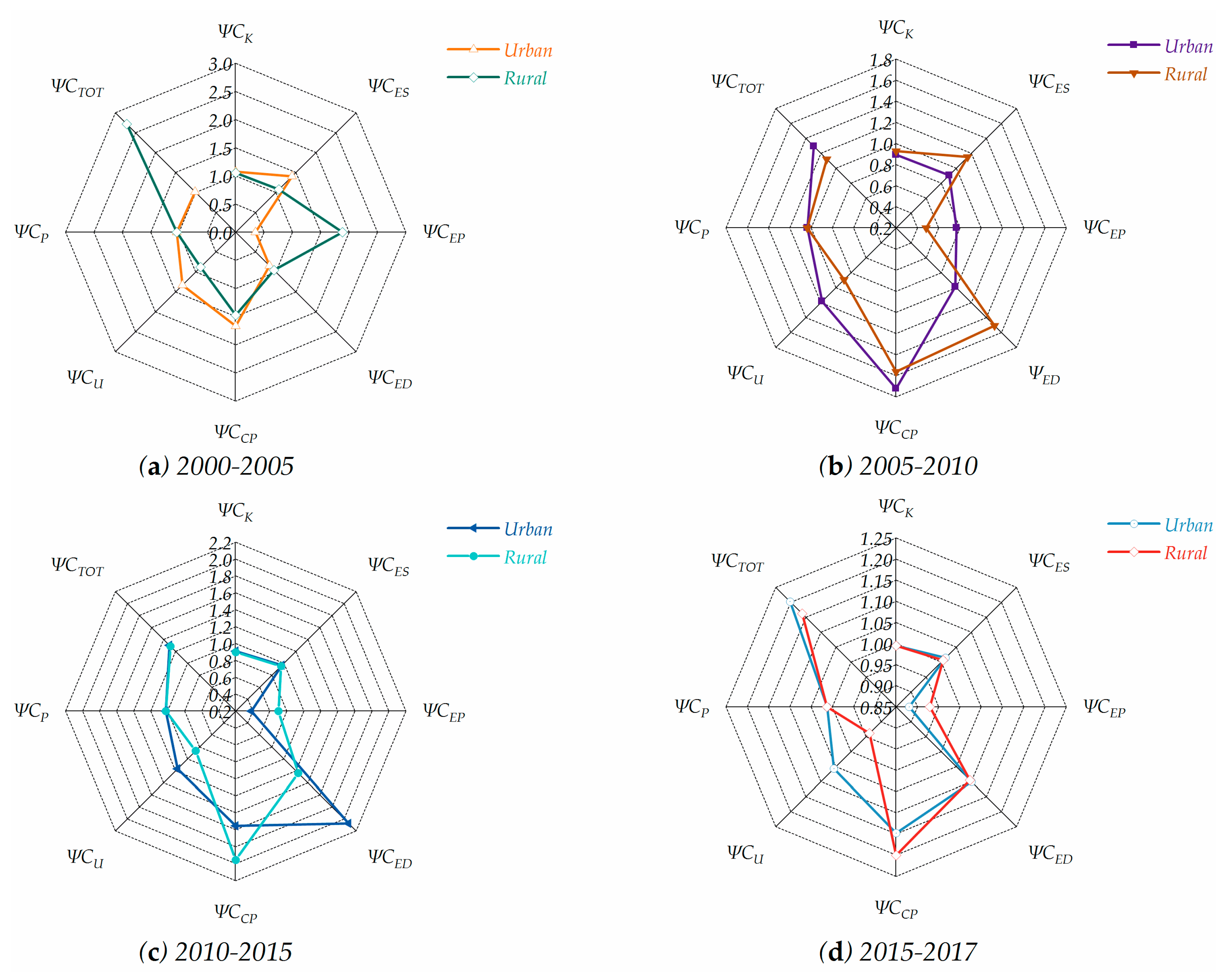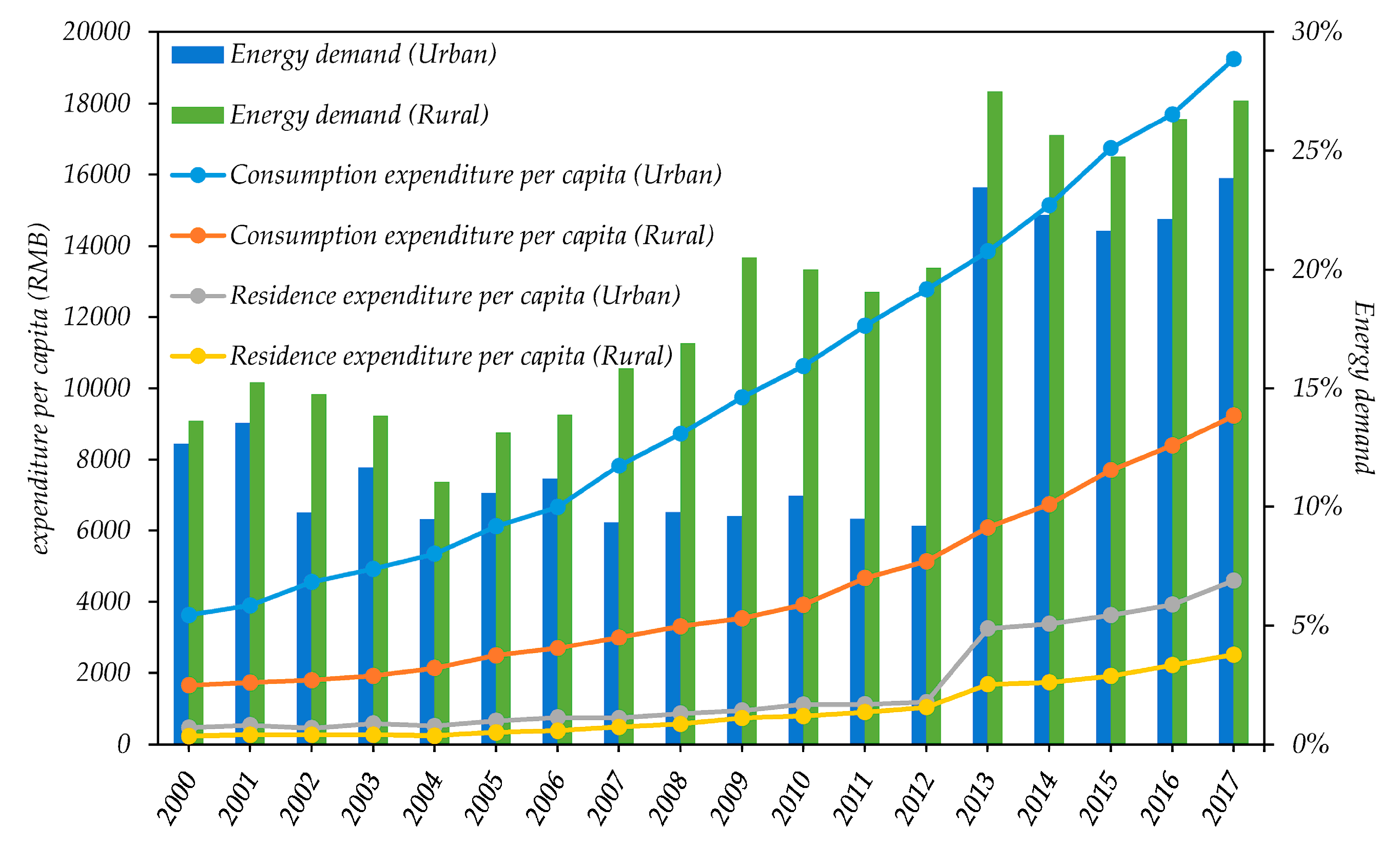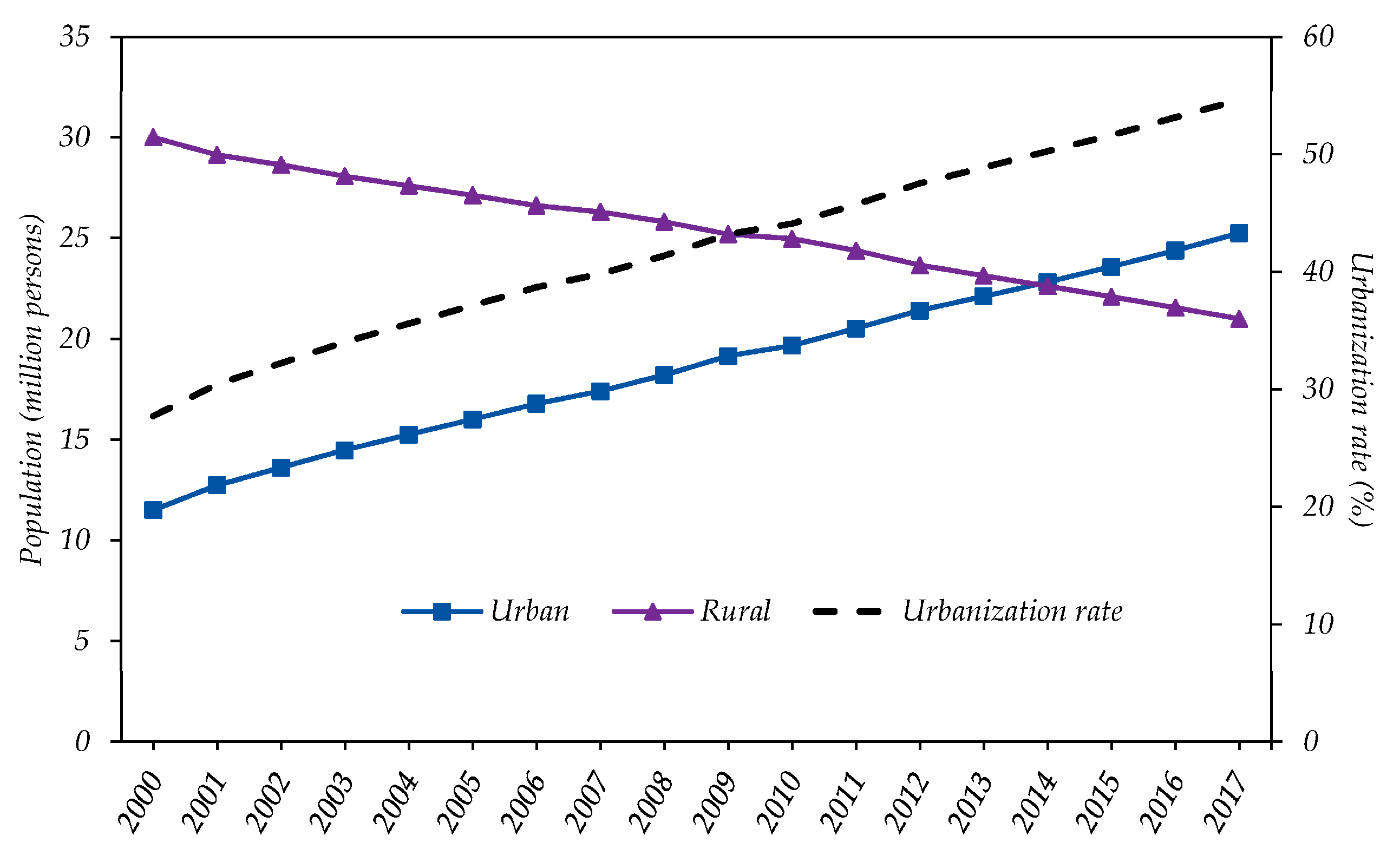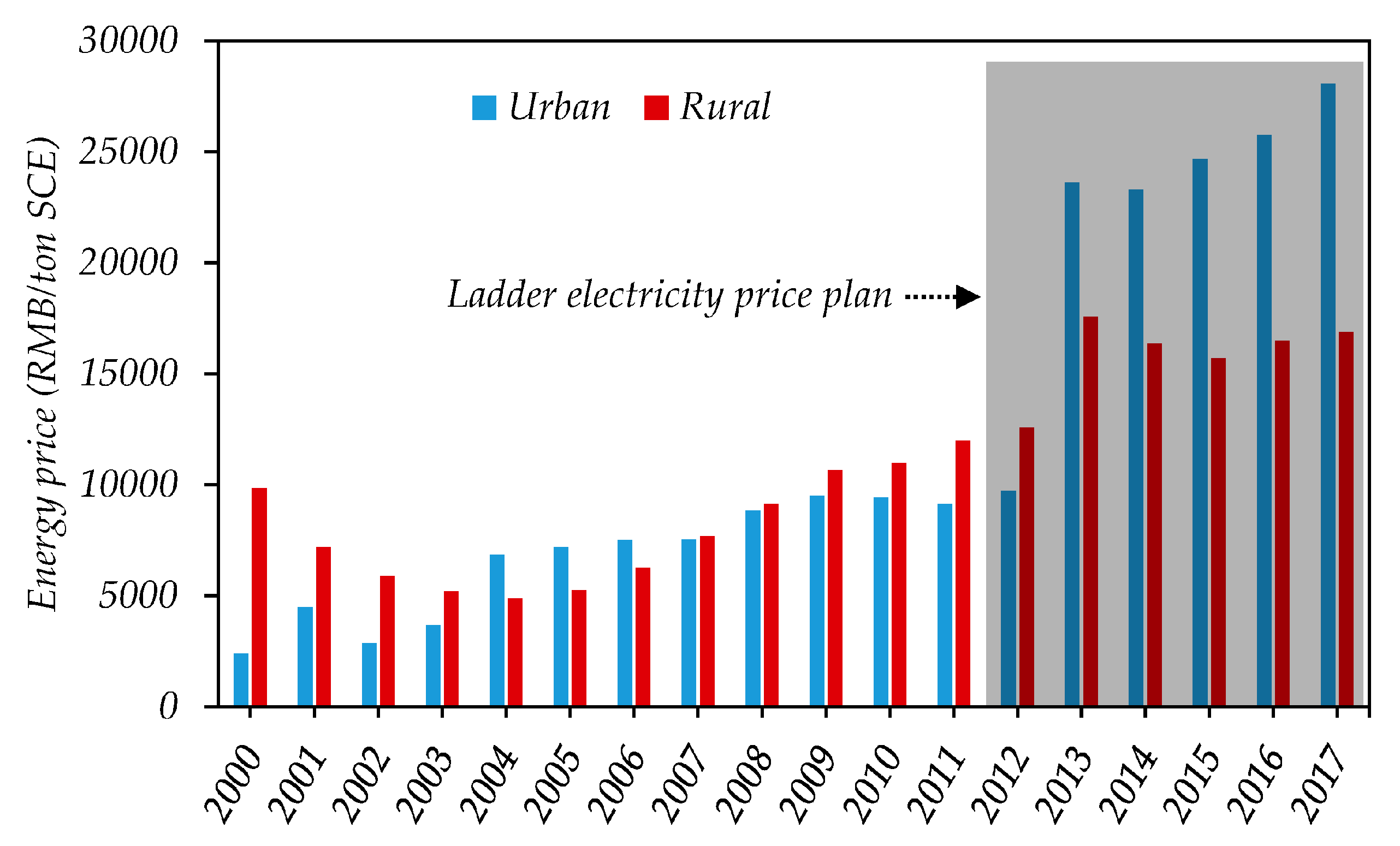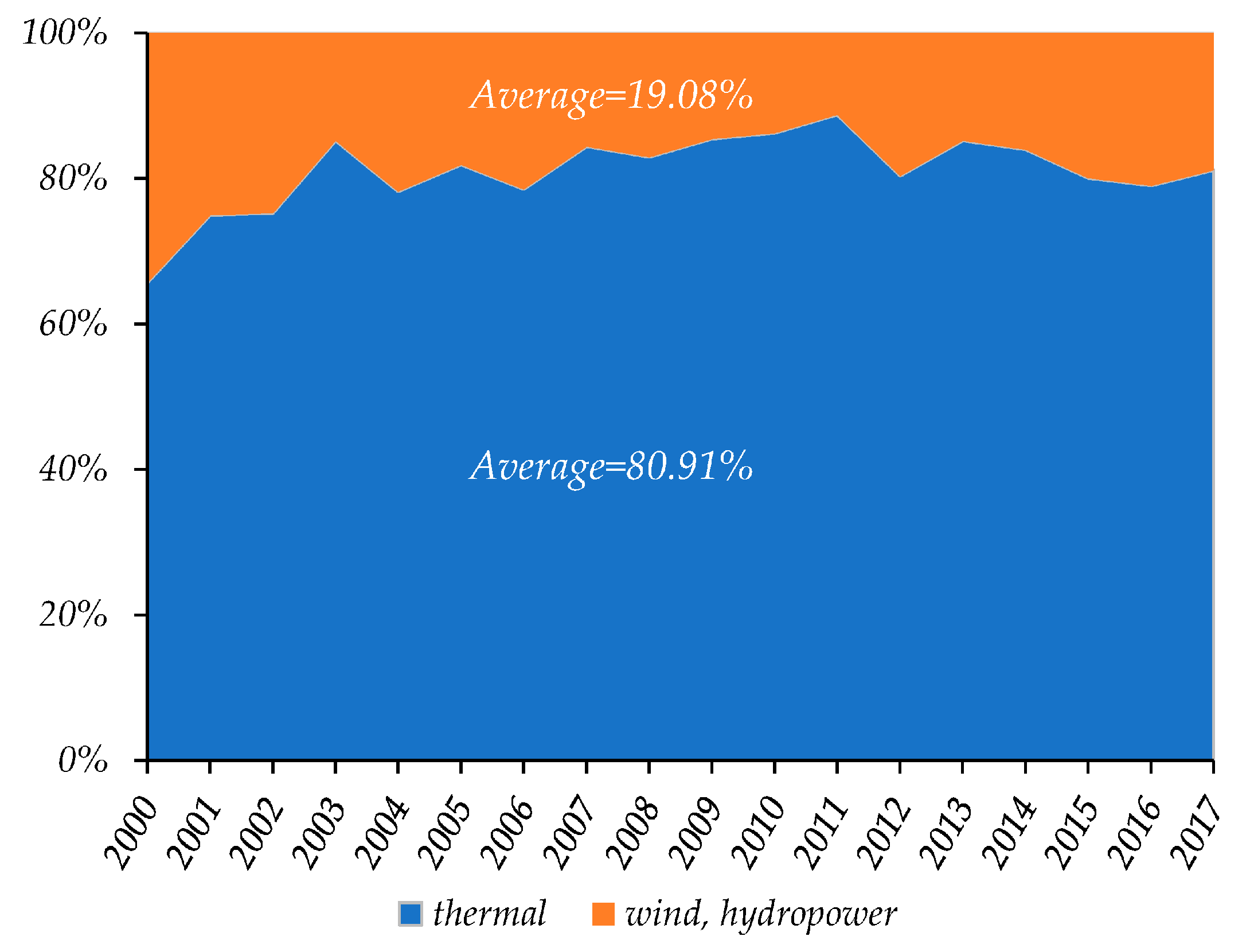1. Introduction
The Intergovernmental Panel on Climate Change (IPCC) suggests that climate change is a great threat for human survival and development owing to the anthropogenic greenhouse gas (GHG) emissions [
1,
2]. Since 2006, China has become the largest CO
2 emitter globally [
3]. Currently, its emissions account for approximate one third of the global total emissions [
4,
5]. In this context, China has made commitments and formulated a series of policies to reduce emissions. Meanwhile, there is a consensus that reducing the fast increase of residential CO
2 emissions is a significant pathway to achieve energy-saving and emission-reduction targets in China [
6,
7]. For China, the residential sector is the second-largest energy consumer category as well as primary CO
2 emissions source [
8,
9]. Specifically, the residential sector is responsible for 11.7% of energy consumption and 12.6% of CO
2 emissions in 2015 [
10]. On one hand, after 40 years of “reform and opening up”, China steps into the new development phase. In addition, with its further development of urbanization and industrialization, the residential CO
2 emissions are expected to increase continuously. Thus, it is necessary and significant to study the key driving forces to help raise reasonable and effective mitigation policies to combat climate change [
9]. On the other hand, it is widely appreciated that investment, consumption and export are the troika for economic growth, and it is not wise to simply restrain consumption to mitigate the CO
2 emissions [
11]. In addition, as reported by a recent study that China’s economic prosperity had been coupled with environmental degradation, and suggested that decoupling economic growth from ecological impact had been central to achieve the national sustainable development [
12]. Therefore, it is also necessary and imperative for China to discover a green, low-carbon and sustainable path to coordinate the link between developmental and environmental protection [
13].
In reality, plenty of studies have been conducted to respond to the above concerns for decades in China. They often focused on exploring influencing factors of the CO
2 emissions or energy consumption in the residential sector, based on national or regional perspectives, or analyzing the relationship between economic growth and CO
2 emissions from residential sector. When exploring the drivers affecting residential CO
2 emissions or energy consumption, many factors such as income [
14,
15,
16], population [
9,
11,
17], urbanization [
18,
19], energy intensity (or energy price) [
10,
20,
21], energy structure [
6,
22,
23], floor space (per capita) [
24,
25], education level [
26], etc., were discussed. For example, based on structural decomposition analysis (SDA), Zhu, et al. [
11] studied the indirect residential CO
2 emissions during the period 1992–2005. They argued that population size was not the main reason for the emissions growth anymore, although it promoted the indirect emissions to a certain extent. Using Log-Mean Divisia Index (LMDI), Zhao, et al. [
27] decomposed the residential energy consumption in urban China from 1998–2007 at a disaggregated product level. The results demonstrated that energy price had the positive effect on the emission reduction, while population and income played the key role in the growth of the CO
2 emissions. Simultaneously, more scholars were also awareness of the urban–rural gap or dual society in China, thereby they attempted to research Chinese residential CO
2 emissions or energy consumption based on the perspective. Based on Sato–Vartia index, Liu, et al. [
17] analyzed the impact of China’s increased urban and rural residential consumption on CO
2 emissions from 1992–2007. Furthermore, Fan, et al. [
6] studied the residential CO
2 emissions evolutions in urban–rural divided China and explored the underlying driving forces from the perspective of end-use and behavior by applying Adaptive Weighting Divisia (AWD) decomposition. With the further study on the issue, some researchers extended their scopes and took into account Chinese regional disparity in their related studies. Taking Guangdong, the most developed province in China, as a case study, Wang, et al. [
21] decomposed the influencing factors of direct residential energy-related CO
2 emissions into eight factors by using LMDI. The results showed that residential living standard had the largest contribution to the increase of CO
2 emissions, while energy price was the first inhibiting factor. Similarly, taking Liaoning, a coastal province in northeastern China, as an example, Tian, et al. [
9] explored the driving forces of the residential CO
2 emissions from 2002–2007 based on LMDI. The results suggested that population and per-capita consumption were the main factors to the increase of residential CO
2 emissions, whereas carbon intensity had the negative effect on the residential CO
2 emissions growth. Moreover, based on spatial–regional level, Yuan, et al. [
22] applied LMDI to analyze the drivers of urban and rural residential CO
2 emissions in China’s 30 provinces between 2007 and 2012. They found that population and income-per-capita effects were the main drivers of high urban residential CO
2 emissions in most of the coastal provinces. There were so many studies conducted in many other regions of China. The explanations for these studies can be similarly illustrated, here; we condense some explanations and list some presentative references in
Table 1 to save space.
In the analysis of the pathway to coordinate CO
2 emissions and economic growth, numerous studies were performed using the decoupling analysis. Generally, there are two main decoupling methods, i.e., OECD indicator and Tapio decoupling indicator [
28,
29]. Compared with OECD indicator, the latter was more accurate and flexible, which greatly improved OECD indicator. Therefore, Tapio decoupling indicator was more popular and widely used to analyze the relationship between CO
2 emissions and economic growth. In addition, in China, most of these previous studies focused on the main emission sectors: industry [
13,
30]; transportation [
31,
32]; construction [
33,
34]; agriculture [
35,
36]. To the best of our knowledge, a few scholars applied the Tapio decoupling indicator to analyze the nexus between CO
2 emissions and economic growth from the residential sector. Based on the Tapio decoupling indicator, Ye, et al. [
20] conducted the study to analyze the relationship between residential CO
2 emissions and economic growth in China from 1994–2012, which ignored the regional disparity and urban–rural gap. Using the OECD indicator, Yuan, et al. [
22] studied the decoupling status in China’s 30 provinces from the residential sector with little content.
Therefore, from
Table 1, we can conclude that to date, researchers have mainly focused on developed regions especially coastal provinces and cities such as Guangdong, Liaoning, Jiangsu, Shandong and urban agglomerations, or on national and its 30 provinces when they conducted the studies on exploring the driving forces of CO
2 emissions in the residential sector. Moreover, few studies were conducted on decoupling analysis of the relationship between CO
2 emissions and economic growth from the residential sector compared with other main sectors. The existing related decoupling analysis studies on the residential sector were far from straightforward. As we all know, there is a consensus that China is a multiple-regional and heterogeneous country with the regional disparity and urban-gap [
10,
23], such as socio-economic, consumption pattern, urbanization, natural resource endowment, energy use, etc. Indeed, China’s mitigation targets need all regions’ efforts. However, this country’s less developed and underdeveloped regions have not yet received academic attention, and few findings can be found in the existing studies worldwide. It is thus crucial to study these less developed and undeveloped regions. This can complete CO
2 emissions profile and help those regions’ decision-makers make reasonable mitigation policies on residential sector by fully considering the local situations.
Under such a circumstance, this paper aims to make up for the above-mentioned deficiencies by fully considering urban–rural gap and regional disparity; we take Jiangxi, a typical less developed province in central China, as a case study.
Figure 1 shows its location. Jiangxi is in central China with an administrative area of 166,900 km
2. Statistically, its total gross domestic product (GDP) reached 2001 billion RenMinBi (RMB) in 2017 [
37], which ranked 16 among all 31 regions of China. To the best of our knowledge, its capital city, Nanchang, was assigned the task of pursuing a low-carbon economic transformation in China’s first “Low-Carbon Pilot Cities” national project in 2010 [
9,
38]. More recently, Jiangxi, Fujian, and Guizhou are selected as the first national ecological civilization test beds in 2016, aiming to set up the relatively sound ecological mechanism for China. According to these facts, we can know that Jiangxi had the huge potential of increasing its CO
2 emissions on residential sector with its further development. However, little academic attention was paid to Jiangxi, especially its residential sector. Thus, based on data availability, we first attempt to overview the situation of residential energy-related CO
2 emissions in Jiangxi urban and rural regions. Then, the driving forces affecting the residential energy-related CO
2 emissions in urban and rural regions are explored by using LMDI. In addition, the Tapio decoupling model was applied to analyze the relationship between the residential energy-related CO
2 emissions and economic growth (consumption expenditure). We believe this study has some innovative significance to help this province make mitigation policies and provide important insight for China’s other less developed or undeveloped regions to reduce emissions.
The remainder of this paper is organized as follows:
Section 2 depicts the methodology and data description. Results and discussions are given in
Section 3. The main conclusions and corresponding policy implications are provided in
Section 4.
4. Conclusions and Policy Implications
4.1. Main Conclusions
Presently, residential energy consumption has become the second-largest sector to the industrial energy consumption in China. However, little attention was paid to research the difference of the residential energy-related CO2 emissions between urban and rural areas in the less developed and undeveloped regions. Thus, based on the urban–rural duality, this paper aims at exploring the difference of the residential energy-related CO2 emissions in Jiangxi urban and rural regions from 2000–2017. We first overviewed the changes of the residential energy-related CO2 emissions in Jiangxi between urban and rural regions. Then, the LMDI method was introduced to distinguish the major factors affecting the residential energy-related CO2 emissions. In addition, the Tapio decoupling model was used to analyze the relationship between residential energy-related CO2 emissions and consumption expenditure. The main results were acquired as follows.
The residential energy-related CO2 emissions rapidly increased after 2008 in both Jiangxi urban and rural regions. However, the annual growth rate of urban regions (7.47%) was faster than rural regions (6.03%). In addition, the gap between urban and rural regions became narrowed and stable. The energy structures of both urban and rural residential energy-related CO2 emissions had shifted from coal-dominant to a multiple structure which consisted of oil, natural gas, and electricity. Specifically, the energy-related CO2 emissions structure was electricity, oil, natural gas, and coal in sequence for urban; it was electricity, coal, oil, and natural gas in sequence for rural. As for the residential energy-related CO2 emissions per capita, it showed a decline trend in urban regions, while an increasing tendency in rural regions over the study period. The gap in residential energy-related CO2 emissions for urban and rural residents narrowed from 2000–2007.
The energy price effect played the most important role in reducing the residential energy-related CO2 emissions in both urban and rural regions. In addition, the carbon emission coefficient had a minor effect on decreasing urban and rural residential energy-related CO2 emissions. The results showed that urbanization exerted a positive effect on increasing the urban residential energy-related CO2 emissions, but decreasing the rural residential energy-related CO2 emissions. Consumption expenditure-per-capita effect was the most important factor increasing the residential energy-related CO2 emissions in both urban and rural regions, followed by energy demand. From 2000–2017, population effect and energy structure played a minor role in increasing the urban and rural residential energy-related CO2 emissions.
Over the study period, four decoupling status (END, SD, WD, and EC) occurred in both urban and rural regions when analyzed the relationship between consumption expenditure and residential energy-related CO2 emissions. Overall, the decoupling state for urban and rural regions were the WD and END. This showed that residential energy-related CO2 emissions in urban Jiangxi was less depend on consumption expenditure, but rural residential energy-related CO2 emissions still depended on consumption expenditure.
4.2. Policy Implications
First, since the residential energy-related CO2 emissions caused by coal was still high in rural regions, which accounted for 27.52% and was second only to electricity (53.78%) even in 2017. However, the corresponding proportion of natural gas was always low and took up less than 1% over the study period. Thus, the energy structure of rural regions had more space to optimize, and more efforts should be paid to further adjust the rural energy structure. For instance, promoting the proportion of natural gas and encouraging the use of renewable and clean energy in rural regions.
Second, since the rural residential energy-related CO2 emissions per capita had exceeded that of the urban region after 2015, thereby suggesting that the lifestyles in rural regions were more extensive and lower energy efficiency compared with urban regions. On one hand, it is urgent and imperative for the government at all levels to strengthen related public education and guide residents to shift their high-carbon lifestyles to a green and low-carbon pattern, especially for rural residents. In addition, the government should accelerate the elimination of backward production capacity to improve the efficiency in rural regions. On the other hand, residents themselves should also initiatively adapt to the transformation and cultivate the awareness of environmental protection.
Third, consumption expenditure-per-capita effect became the most factor increasing the residential energy-related CO2 emissions in both urban and rural regions. With the improvement of economic growth and living standards, people had the desire and capacity to pursuit the quality of life and buy more energy-intensive electricity appliances and private transport tools. However, it is not wise to reduce the CO2 emissions via restraining the consumption, this was because the consumption was a critical impetus of socio-economic development. Thus, the government could apply the fiscal and tax policy to cut down the residential energy-related CO2 emissions and accelerate the decoupling. Specifically, the government should continue to impose the “Home Appliances Subsidy Program” and monitor its proper extent of implementation. For the high-carbon and extensive goods and services, the government could add the tax to restrain the CO2-intensive commodities’ consumption. Meanwhile for the energy-saving appliances, reducing the tax could stimulate the low-carbon consumption. Moreover, more investment and efforts were needed to improve public transport infrastructures and the energy conservation technology.
Fourth, considering energy price played the most important role in decreasing the residential energy-related CO2 emissions in both urban and rural regions, indicating tiered energy price was the effective and scientific pathway to achieve energy savings and emissions reduction. In light of the fact, the government needs further to uphold and ameliorate the energy price policy in the future. In particular, when applying the energy price mechanism, the duality as well as inequality of income level and economic development should be comprehensively considered in urban and rural regions.
Last, to the best of our knowledge, residential building energy consumption accounted for a large proportion of the total residential energy consumption, leading to enormous CO2 emissions. Therefore, it is necessary to improve residential building energy efficiency, especially for rural regions. For urban regions, the intelligent energy management technology in household could be popularized and applied to achieve energy conservation.

